Lebanon, Ohio
| City of Lebanon, Ohio | |
|---|---|
| City | |

Broadway Street
|
|
 Location of Lebanon, Ohio |
|
 Location of Lebanon in Warren County |
|
| Coordinates: 39°25′36″N 84°12′45″W / 39.42667°N 84.21250°WCoordinates: 39°25′36″N 84°12′45″W / 39.42667°N 84.21250°W | |
| Country | United States |
| State | Ohio |
| County | Warren |
| Area | |
| • Total | 12.97 sq mi (33.59 km2) |
| • Land | 12.96 sq mi (33.57 km2) |
| • Water | 0.01 sq mi (0.03 km2) |
| Elevation | 768 ft (234 m) |
| Population (2010) | |
| • Total | 20,033 |
| • Estimate (2012) | 20,387 |
| • Density | 1,545.8/sq mi (596.8/km2) |
| Time zone | Eastern (EST) (UTC-5) |
| • Summer (DST) | EDT (UTC-4) |
| ZIP code | 45036 |
| Area code(s) | 513 |
| FIPS code | 39-42364 |
| GNIS feature ID | 1042462 |
| Website | http://www.ci.lebanon.oh.us |
Lebanon is a city in and the county seat of Warren County, Ohio, United States, in the state's southwestern region, within the Cincinnati metropolitan area. The population was 20,033 at the 2010 census. Lebanon is widely known as a tourist destination, with its many points of interest, historic landmarks, regional festivals and downtown shopping. The city also has a symphony orchestra and chorus.
Lebanon is in the Symmes Purchase. The first European settler in what is now Lebanon was Ichabod Corwin uncle of Ohio Governor Thomas Corwin who came to Ohio from Bourbon County, Kentucky and settled on the north branch of Turtle Creek in March 1796. The site of his cabin is now on the grounds of Berry Intermediate School on North Broadway and is marked with a monument erected by the Warren County Historical Society.
The town was laid out in September 1802 on land owned by Ichabod Corwin, Silas Hurin, Ephraim Hathaway, and Samuel Manning in Sections 35 and 35 of Town 5, Range 3 North and Sections 5 and 6 of Town 4, Range 3 North of the Between the Miami Rivers Survey. Lebanon was named after the Biblical Lebanon because of the many juniper or Eastern Redcedar trees there, similar to the Lebanon Cedar. It is known today as "The Cedar City".
City legend has it that Lebanon didn't grow as large as Cincinnati or Dayton because of the 'The Shaker Curse.' During their migration, the Shakers decided an area outside of town was a suitable place for them to create a homeland for themselves. There was a disagreement with some of the locals and it was said the Shakers placed a curse on the city to hinder the city's prosperity. In reality, the Shakers thrived in the area, and built a settlement about 4 miles west of Lebanon called Union Village. A local man, Malchalm Worley was their first convert. Since the Shakers did not engage in procreation, they relied on converts to increase their numbers. By 1900, there were almost no Shakers left in Ohio.
...
Wikipedia
